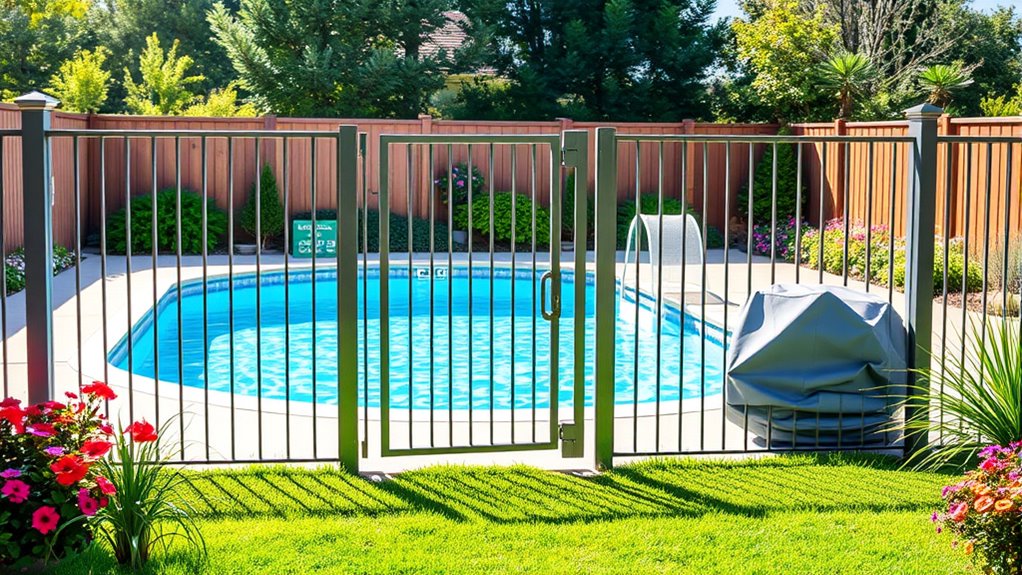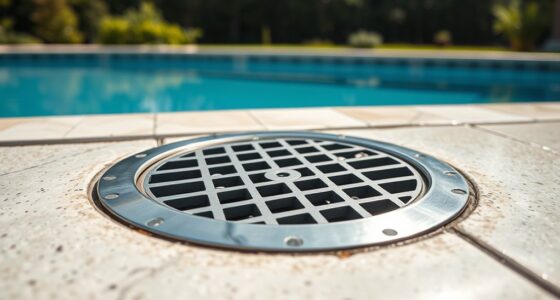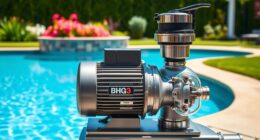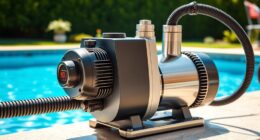To childproof your pool, install a secure four-foot-high fence with no gaps, and make sure gates self-close and latch high out of children’s reach. Use alarms on doors and the water to alert you of any unexpected entry. Always supervise children closely, enforce clear safety rules, and keep rescue equipment nearby. Regularly maintain your pool area and practice emergency plans; you’ll find even more ways to keep your loved ones safe as you continue exploring.
Key Takeaways
- Install secure fencing at least four feet high with self-closing, self-latching gates to block access.
- Use pool alarms and safety devices like life rings and reaching poles for quick emergency response.
- Maintain constant supervision and enforce strict pool rules, ensuring children are within arm’s reach at all times.
- Keep the pool area clean, well-lit, and slip-resistant, and regularly inspect equipment and electrical systems.
- Educate children about water hazards, teach CPR, and practice emergency plans regularly for preparedness.
Installing Secure Pool Fencing and Barriers

Installing secure pool fencing and barriers is one of the most effective ways to prevent accidental drownings. You should choose a fence that is at least four feet high, with no gaps or openings that a child could squeeze through. Make sure the gate self-closes and latches automatically, so it can’t be left open unintentionally. Use a latch that is out of reach of children, ideally at least 54 inches above the ground. Regularly inspect the fencing for damage or wear, and repair any issues immediately. Keep furniture, ladders, or toys away from the fence to prevent children from climbing over. Proper fencing creates a physical barrier, making it more difficult for kids to access the pool unsupervised and reducing the risk of accidents. Incorporating vertical storage solutions for pool accessories and safety equipment can help keep the area organized and safe. Additionally, understanding safety standards for pool fencing can ensure compliance with local regulations and enhance overall safety.
Using Pool Alarms and Safety Devices
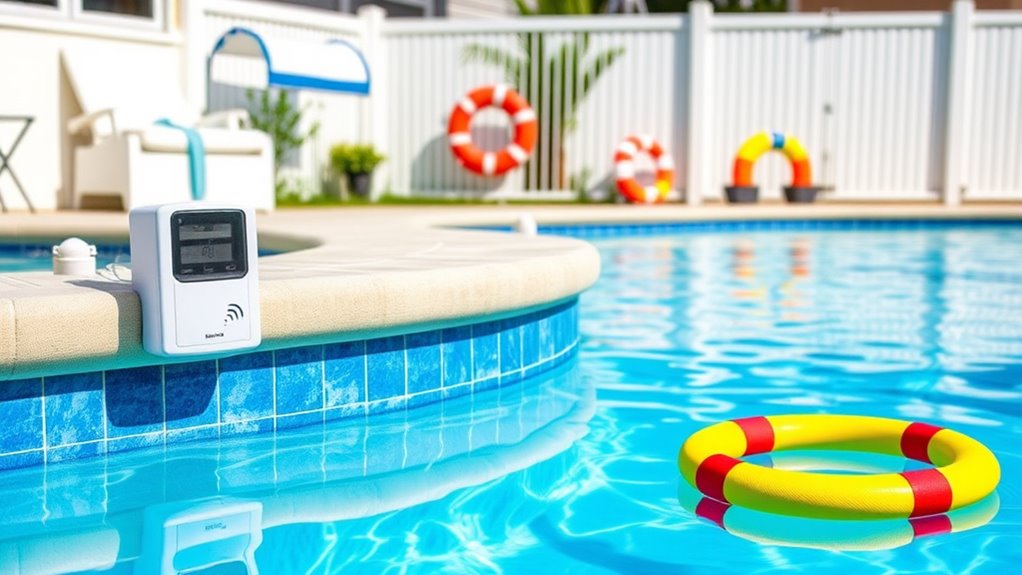
To enhance pool safety, using alarms and safety devices can provide an essential extra layer of protection. Pool alarms alert you immediately if someone enters the water unexpectedly, giving you vital seconds to respond. You can install door alarms on nearby exits or underwater alarms that detect movement or submersion. Safety devices like pool covers, which automatically lock in place, prevent accidental access, and pool nets act as physical barriers. Keep rescue equipment, such as a life ring or reaching pole, nearby and easy to access in case of emergencies. Regularly test alarms to guarantee they work properly, and educate everyone in your household about their purpose. Incorporating pool safety features similar to top projector features, such as alarms and physical barriers, significantly reduces the risk of accidental drownings and keeps your pool area safer for children. Being aware of factors affecting safety can help you identify potential hazards and address them proactively, including considering the AI-powered safety devices that utilize data analytics for enhanced monitoring.
Establishing Strict Supervision Practices
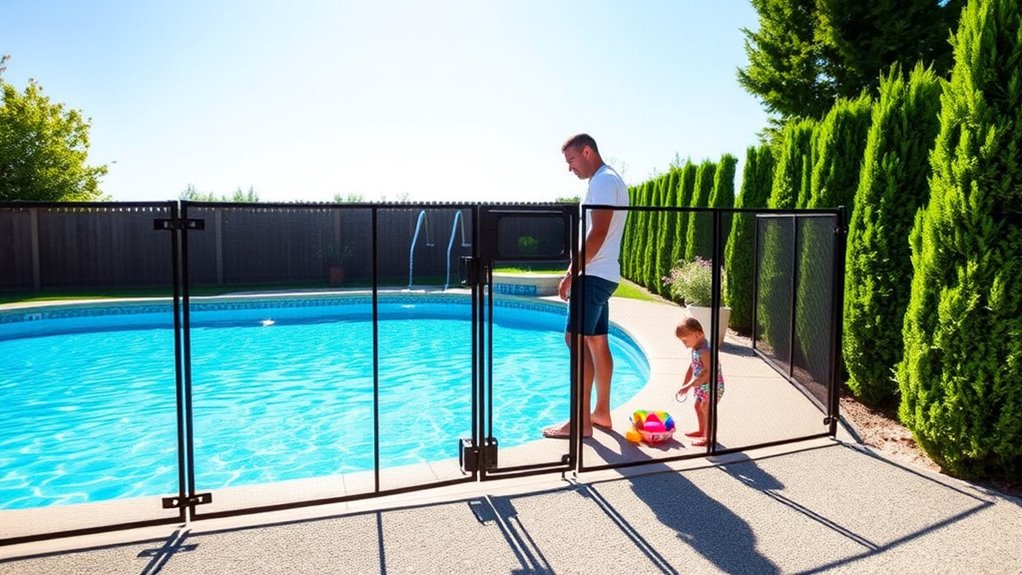
Supervision is the most effective way to prevent accidental drownings in your pool. You need to stay alert and engaged whenever children are nearby. Never leave kids unattended, even for a moment. Assign a responsible adult to watch the pool during all activities. Establish clear rules, like no running or diving, and enforce them strictly. To emphasize the importance, consider this table:
| Supervision Tips | Why It Matters |
|---|---|
| Constant, attentive watching | Prevents quick, unnoticed incidents |
| Designate a “pool watcher” | Ensures accountability |
| Limit distractions | Maintains focus on children |
| Set clear boundaries | Reduces risky behaviors |
Being alert and engaged at all times is crucial to effective supervision. Additionally, understanding and managing emotional responses can help adults stay calm and attentive in potentially stressful situations. Recognizing the importance of supervision practices can further help prevent accidents and promote a safe swimming environment. Consistent supervision techniques are key to establishing a safe and enjoyable swimming experience for everyone involved. Incorporating advanced safety measures, such as pool alarms and safety covers, can provide extra layers of protection.
Providing Proper Safety Equipment and Rescue Tools
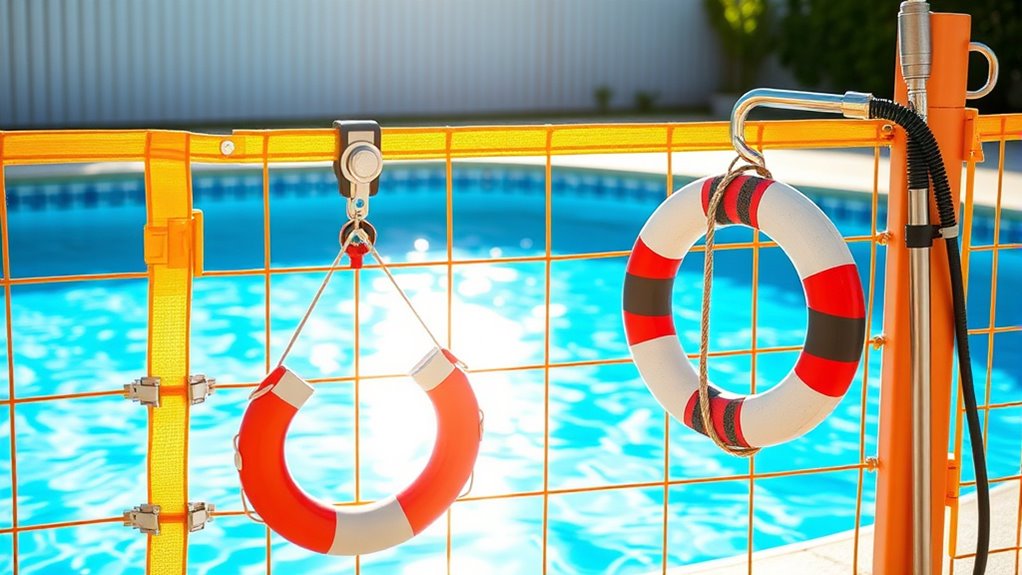
You need to have the right safety gear on hand, like life rings and reaching poles, to help in emergencies. Make sure rescue devices are easy to see and reach at all times. Proper storage keeps equipment accessible and prevents accidents when they’re not in use.
Essential Safety Gear
Have you equipped your pool area with the right safety gear? Proper safety equipment can make all the difference in preventing accidents and responding quickly if needed. Make certain you have:
- A sturdy reaching pole or shepherd’s hook for quick rescue
- Life jackets or floatation devices suitable for children
- A reliable first aid kit, easily accessible nearby
- An emergency whistle to alert others in case of trouble
These tools are essential for immediate response and peace of mind. Keep them in a designated, visible spot so everyone knows where to find them quickly. Regularly check the equipment for damage or wear, replacing anything that’s compromised. Having the right safety gear ready ensures you’re prepared to act swiftly and effectively, helping keep your little ones safe around the pool.
Accessible Rescue Devices
Accessible rescue devices are essential to ensuring quick and effective responses during emergencies. You want rescue tools within easy reach so you can act immediately if someone is in distress. Keep items like life hooks, reaching poles, or rescue rings near the pool edge at all times. Make certain these devices are in good condition and clearly visible, so there’s no delay when seconds count. Avoid storing rescue equipment in locked cabinets or hard-to-reach areas; accessibility saves lives. Regularly check that rescue devices are intact and ready for use. Proper placement and maintenance ensure you can respond swiftly, minimizing the risk of drowning or injury. Remember, having accessible rescue devices is a critical part of your pool safety plan.
Proper Equipment Storage
Proper storage of safety equipment and rescue tools is essential for guaranteeing quick access during emergencies. You want these items to be immediately reachable when seconds count. Store rescue equipment in a designated, clearly marked area near the pool, away from children but easily accessible to adults. Use weatherproof containers to prevent rust and damage, and keep equipment organized for rapid deployment. Regularly inspect and maintain your gear to ensure it’s ready to use. Consider adding a safety checklist nearby to verify all items are in place and functional. Key safety tools include:
- Life rings or floatation devices
- Rescue hooks or reaching poles
- First aid kits
- Emergency contact information
Storing these properly can make all the difference in a crisis.
Educating Children About Water Safety
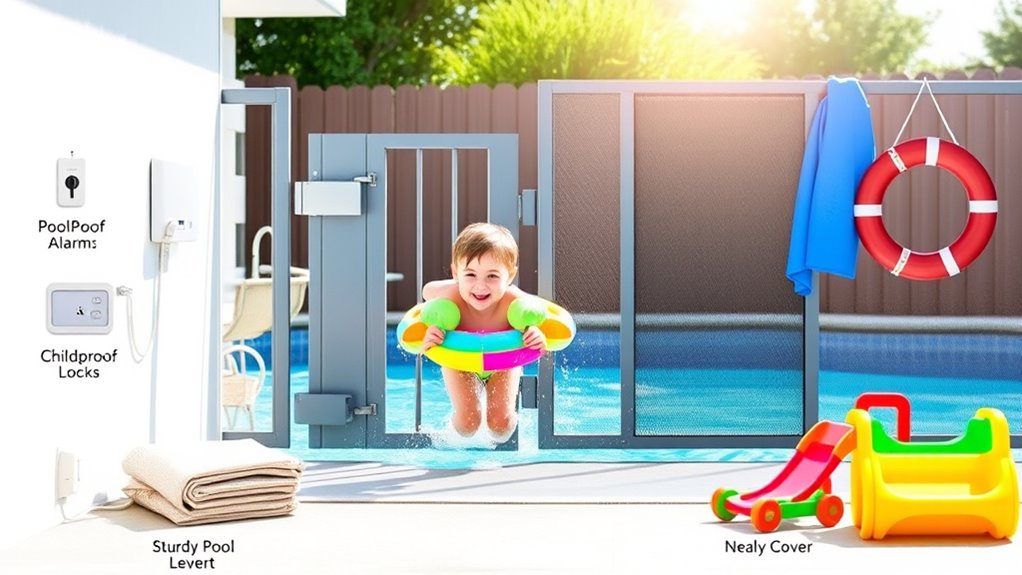
You need to teach your children essential water safety rules to prevent accidents. Supervised swimming practices help them learn how to stay safe around the pool, and recognizing water hazards keeps them alert. By actively educating your kids, you create a safer environment for everyone.
Teaching Water Safety Rules
Teaching children water safety rules is essential for preventing accidents and ensuring they understand how to stay safe around the pool. Clear, consistent rules help children recognize boundaries and develop good habits. Explain simple guidelines like never running near the pool, not swimming alone, avoiding diving in shallow areas, and staying within designated swimming zones. Reinforce these rules regularly and lead by example. Use everyday conversations to remind your kids why these rules matter and how they protect them. You can also create visual aids or charts that children can refer to easily. Consistent enforcement helps children internalize safety habits, reducing the risk of accidents. Remember, teaching water safety is an ongoing process that empowers your children to enjoy the pool responsibly.
Supervised Swimming Practices
Supervised swimming practices are essential for ensuring children stay safe in and around the pool. Always watch your kids closely when they’re swimming, even if they’re experienced. Designate a responsible adult to supervise at all times—never leave children unattended, even for a moment. Keep children within arm’s reach, especially young or inexperienced swimmers. Establish clear rules, like no running or rough play near the pool, and enforce them consistently. Teach children to stay within designated swimming areas and to avoid diving into shallow water. Encourage regular breaks to prevent fatigue, which can lead to accidents. Remember, active supervision isn’t just about being present; it’s about paying full attention and being ready to respond immediately if needed. This vigilance is key to preventing drownings and injuries.
Recognizing Water Hazards
Understanding water hazards is essential for keeping children safe in and around the pool. Children often underestimate dangers, so it’s vital to teach them how to recognize risks. Water hazards include deep areas, slippery surfaces, pool drains, and unexpected currents. Make sure your children know to avoid these dangers and stay alert at all times.
To help them stay safe, educate your kids about:
- The dangers of deep water and how to stay in shallow areas
- Slippery surfaces that can cause falls
- Pool drains and suction hazards
- Unexpected currents or waves in the pool
Maintaining Pool Area Hygiene and Clear Visibility
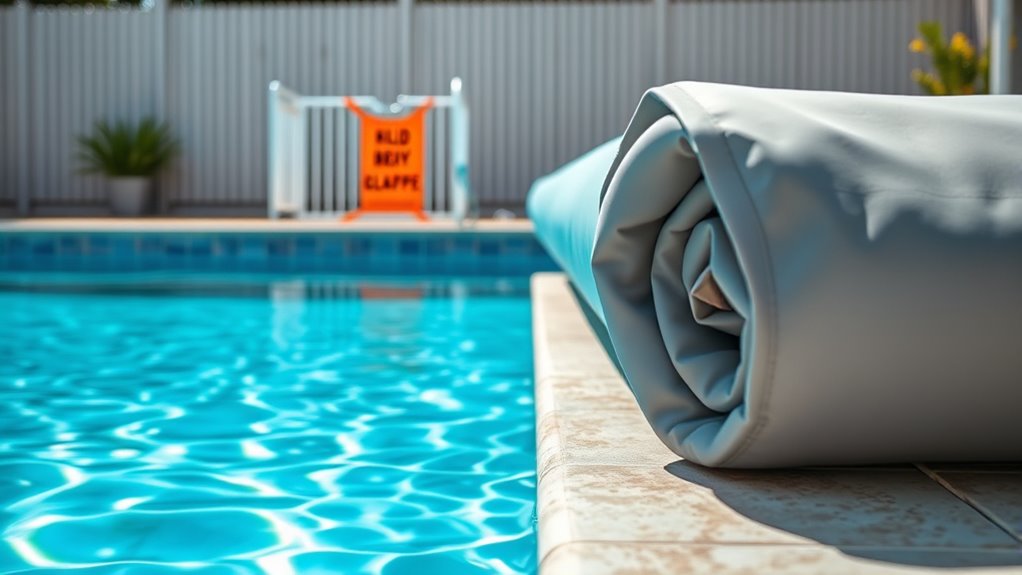
Keeping your pool area clean and visibility clear is essential for safety and enjoyment. Regularly skim debris, sweep the deck, and empty trash to prevent slips and hidden hazards. Use pool skimmers and vacuums to keep the water free of leaves, bugs, and dirt. Clear water allows you to spot potential dangers quickly. Incorporating outdoor safety features like proper lighting and non-slip surfaces further enhances safety and peace of mind. Regular maintenance and attention to tuning can also help ensure your pool equipment operates smoothly, reducing the risk of malfunctions that could compromise safety. Additionally, ensuring your pool’s electrical systems and lighting are Tesla Fire Incidents free from hazards is a smart safety measure. Recognizing the importance of pool safety measures can significantly decrease accidents and increase enjoyment for everyone. To further improve safety, consider regularly inspecting your pool’s diving boards and ladders for stability and secure installation.
Developing Emergency Response Plans
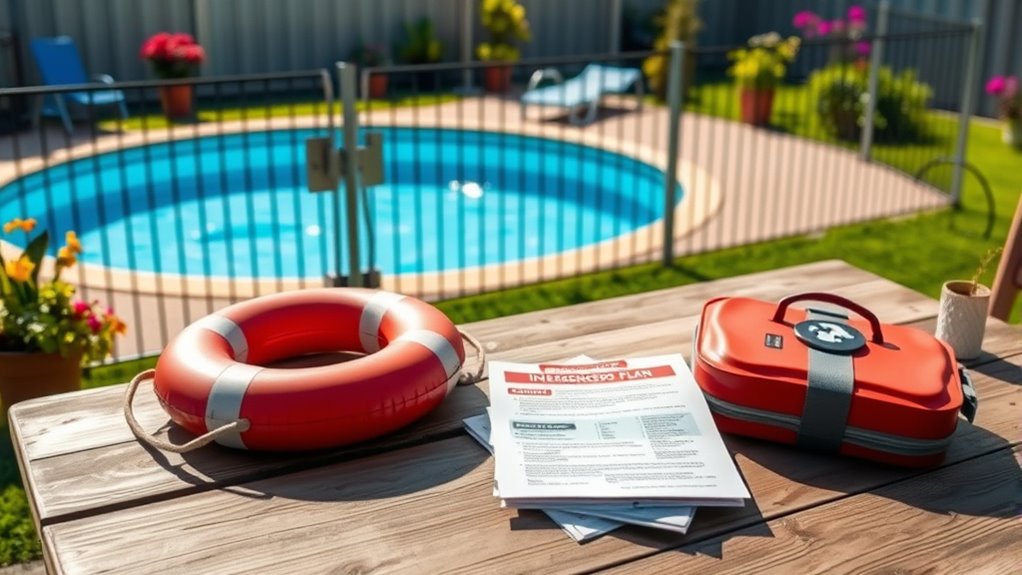
Having an emergency response plan in place is crucial to guarantee quick and effective action if an accident occurs around your pool. You need clear steps to follow, so everyone knows what to do immediately. Practice these plans regularly with your family and guests to ensure swift responses. Your plan should include:
- Calling emergency services immediately and providing clear location details
- Knowing CPR and rescue techniques for drowning victims
- Assigning roles to family members for rescue, contact, and crowd control
- Keeping essential safety equipment, like a life ring and first aid kit, easily accessible
- Educating all pool users about vetted safety products to prevent accidents before they happen
Frequently Asked Questions
How Often Should Pool Safety Equipment Be Inspected or Replaced?
You should inspect your pool safety equipment regularly to make sure it’s in good condition, ideally once a month. Check for any damage, wear, or missing parts. Replace or repair items immediately if you notice issues, especially lifesaving devices like life rings or hooks. After severe weather or heavy use, do a quick inspection. Staying vigilant keeps your pool safe and ready whenever needed, giving you peace of mind.
What Are the Latest Technological Advancements in Pool Safety Devices?
The latest advancements in pool safety devices include smart technology that enhances security. You can now install sensors that detect movement or unauthorized access, alerting you immediately via your smartphone. Automatic covers and fences with integrated sensors provide extra protection. Additionally, innovations like digital pool alarms with quieter, more reliable alerts assist you in staying aware of potential dangers. These cutting-edge tools make it easier for you to guarantee your pool remains a safe environment.
How Can I Involve Children in Safety Education Effectively?
You can involve children in safety education effectively by making it engaging and age-appropriate. Use fun activities like safety games, storytelling, or demonstrations to teach them pool rules. Encourage questions and discussions to keep them involved. Reinforce lessons regularly, and set a good example with your own behavior. When kids understand the importance of safety, they’re more likely to follow rules and stay alert around the pool.
Are There Specific Regulations for Pool Fencing Height and Gate Locks?
You should know that specific regulations for pool fencing height and gate locks vary by location. You need to check your local building codes and safety standards, which often require fences to be at least 4 feet high with self-closing, self-latching gates. These rules help prevent accidental access, so verify your fence and gate meet or exceed these standards to keep children safe around your pool.
What Are Signs of Water Distress in Children That Parents Should Recognize?
Imagine the water turning into a wild, roaring beast that’s threatening your child’s safety. You should watch for signs like struggling to breathe, frantic arm flailing, or sudden silence—indicators they’re in water distress. If you see them panicking, gasping, or going under with no response, act immediately. Recognizing these urgent signs can save their life, making your quick response the ultimate lifeline.
Conclusion
Remember, safety is a journey, not a destination. By installing secure barriers, using alarms, and supervising constantly, you’re creating a safe environment where accidents are less likely. Equip yourself with rescue tools, educate your children, and keep the area clear and hygienic. Practice emergency plans regularly so everyone knows what to do. As the saying goes, “An ounce of prevention is worth a pound of cure.” Stay vigilant, and enjoy your pool safely.
